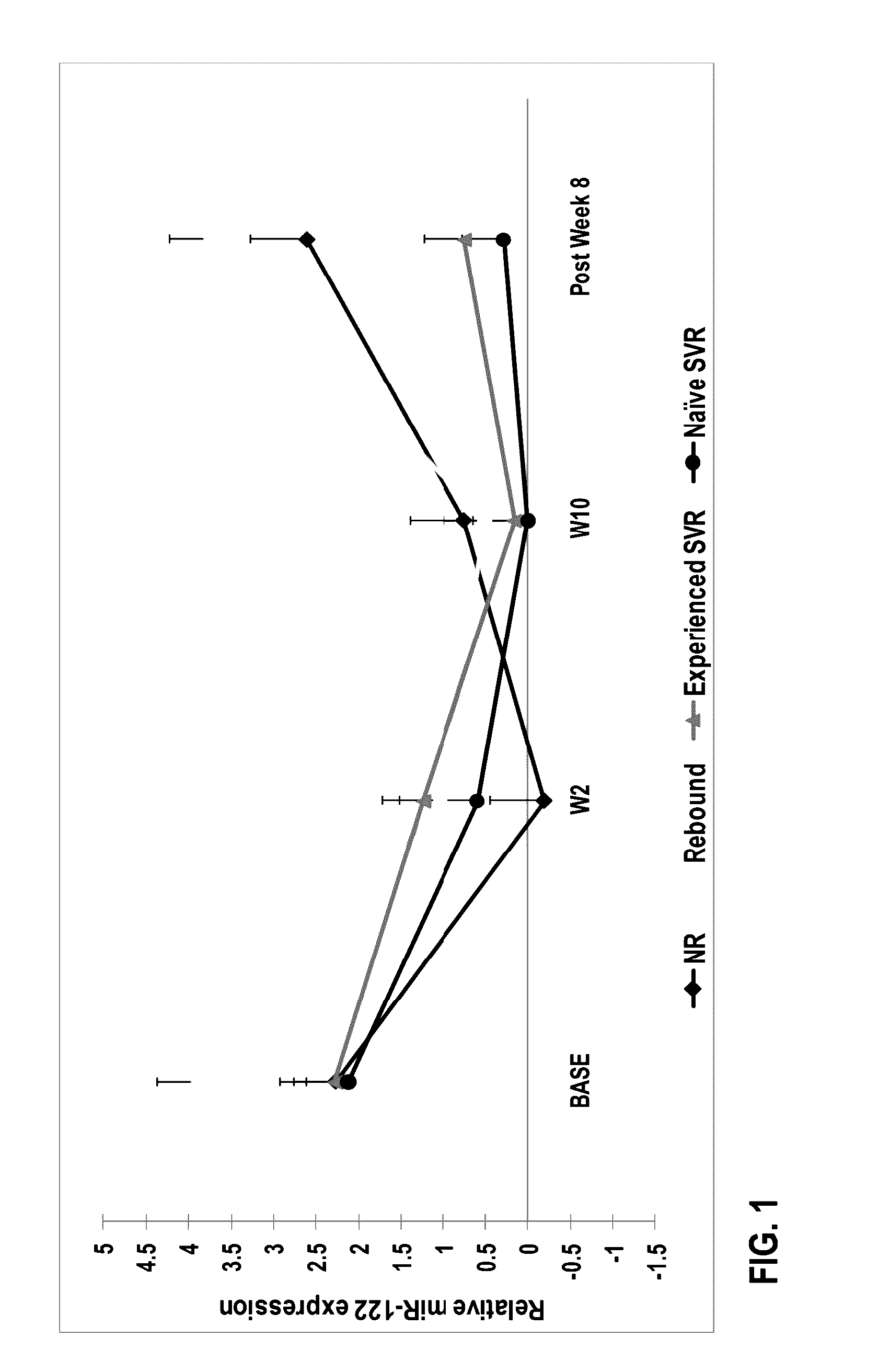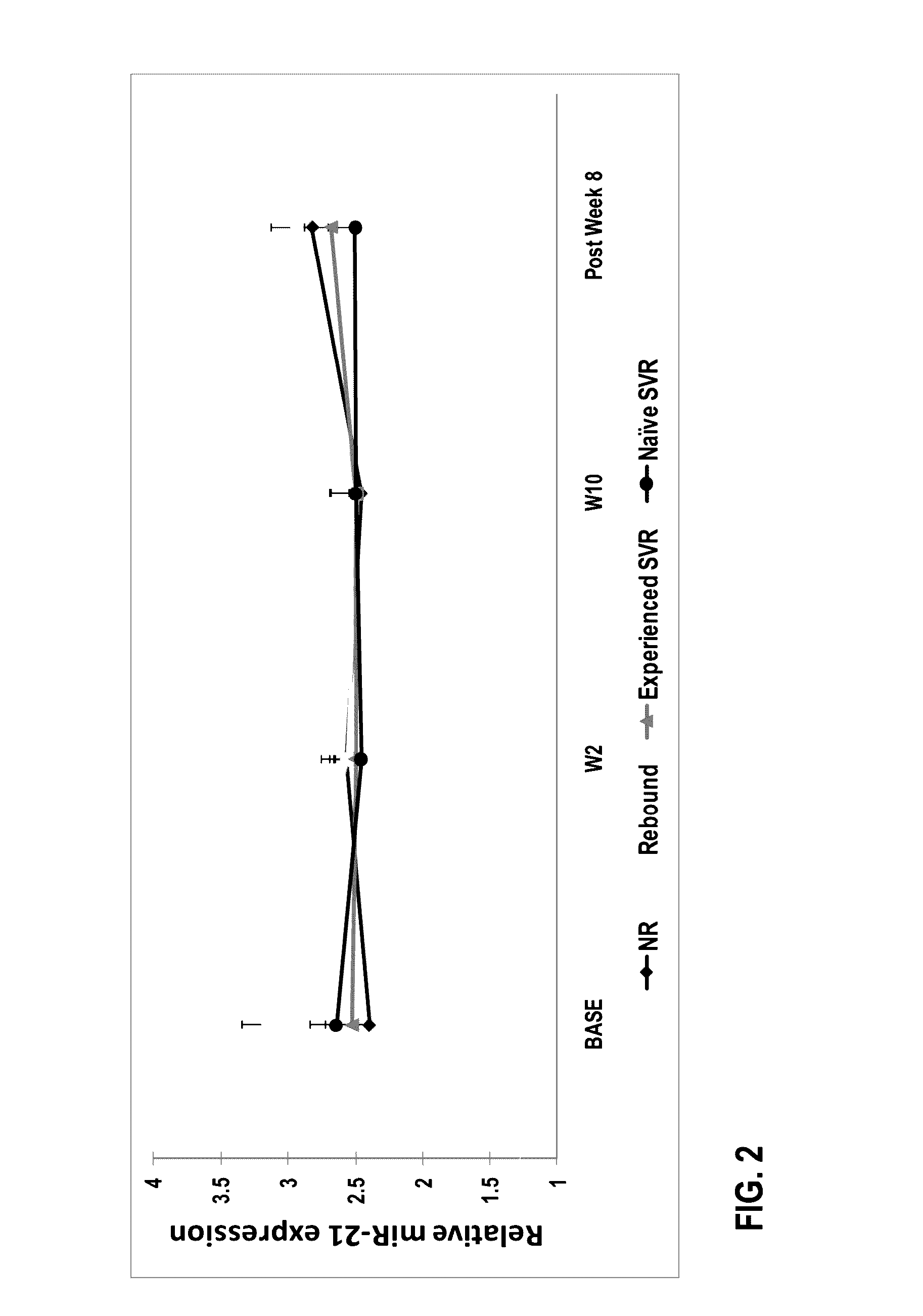Methods for treating hcv
a technology for hepatitis c virus and treatment methods, applied in the field of treatment of hepatitis c virus, can solve the problems of incomplete viral elimination from the body, substantial limitations in efficacy and tolerability, etc., and achieve the effects of improving pharmacokinetics or bioavailability, and reducing mir-122 or mir-21 expression levels
- Summary
- Abstract
- Description
- Claims
- Application Information
AI Technical Summary
Benefits of technology
Problems solved by technology
Method used
Image
Examples
example 1
Use of Direct-Acting Antiviral Regimen with Ribavirin to Treat Treatment-Naïve or Non-Responder Subjects Infected with HCV Genotype 1
[0120]Group A. Previously untreated subjects having HCV infection were treated with a protease inhibitor (in combination with ritonavir), a polymerase inhibitor, and ribavirin. The treatment was without interferon.
[0121]Subjects included 14 treatment naïve subjects between the ages of 18 and 65. One subject discontinued the study at week 1. Therefore, a total of 13 subjects were under study. All of the thirteen subjects completed 12 weeks of therapy with a direct-acting antiviral regimen comprising Compound 1 / r dosed in combination with Compound 2 and RBV. Compound 1 (150 mg QD) was dosed with 100 mg QD ritonavir, 400 mg BID Compound 2, and RBV in treatment naïve subjects infected with GT1 HCV.
[0122]Group B. Peginterferon +ribavirin (P / RBV) treatment-experienced patients were treated with a direct-acting antiviral regimen comprising a protease inhibito...
example 2
Use of Direct-Acting Antiviral Regimen Alone and in Combination With Peginterferon α-2a and Ribavirin (PegIFN / RBV) to Treat Treatment-Naïve Subjects Infected with HCV Genotype 1
[0135]Group A. Previously untreated subjects having HCV infection were treated with a polymerase inhibitor for three days. The first three days of treatment were without interferon and without ribavirin. Following three days of monotherapy with the polymerase inhibitor, the subjects received the polymerase inhibitor at the same dose in combination with pegylated interferon / ribavirin (“P / R”) through week 12. At week 12, treatment with the polymerase inhibitor was discontinued and subjects received P / R alone through week 48. Within Group B, subjects received either Compound 4 (100 or 300 or 600 mg QD) or Compound 2 (400 mg BID). Subjects included treatment-naïve subjects between the ages of 18 and 65.
[0136]Group B. Previously untreated subjects having HCV infection were treated with P / R alone for 48 weeks (“SOC...
example 3
Use of Direct-Acting Antiviral Regimen Alone and in Combination With Ribavirin (RBV) to Treat Treatment-Naïve Subjects Infected with HCV Genotype 2 or 3
[0145]Genotype 2 Cohort. Previously untreated subjects having HCV genotype 2 infection were treated with a protease inhibitor (in combination with ritonavir) and an NS5A inhibitor with or without RBV. The treatment was without interferon.
[0146]Subjects included 20 treatment naïve subjects between the ages of 18 and 65. Nine patients completed 12 weeks of therapy with a direct-acting antiviral regimen comprising Compound 1 / r dosed in combination with Compound 3 and RBV. Eight patients completed 12 weeks of therapy with a direct-acting antiviral regimen comprising Compound 1 / r dosed in combination with Compound 3. Compound 1 / r was dosed 200 / 100 mg QD. Compound 3 was dosed 25 mg QD. RBV was dosed 1000-1200 mg daily divided BID, based on weight. Two subjects experienced viral breakthrough and two subjects relapse following treatment.
[014...
PUM
| Property | Measurement | Unit |
|---|---|---|
| weight | aaaaa | aaaaa |
| weight | aaaaa | aaaaa |
| length | aaaaa | aaaaa |
Abstract
Description
Claims
Application Information
 Login to View More
Login to View More - R&D
- Intellectual Property
- Life Sciences
- Materials
- Tech Scout
- Unparalleled Data Quality
- Higher Quality Content
- 60% Fewer Hallucinations
Browse by: Latest US Patents, China's latest patents, Technical Efficacy Thesaurus, Application Domain, Technology Topic, Popular Technical Reports.
© 2025 PatSnap. All rights reserved.Legal|Privacy policy|Modern Slavery Act Transparency Statement|Sitemap|About US| Contact US: help@patsnap.com



